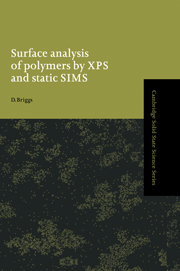Chapter 4 - Static SIMS (SSIMS)
Published online by Cambridge University Press: 08 October 2009
Summary
Instrumentation
SSIMS involves the bombardment of a sample with a low density flux of positive ions (or neutral atoms) and the mass analysis of the positive and negative secondary ions which are emitted from the sample surface. A secondary ion mass spectrometer (or SIMS instrument) therefore consists of a vacuum vessel with its associated pumping system and sample introduction/manipulation systems; a primary ion (or atom) source; a mass spectrometer and its associated secondary ion collection optics; a secondary ion detection system and a dedicated ‘datasystem’ based on a PC or workstation for control of the spectrometer and processing of the acquired data. In addition, when studying insulating samples such as polymers it is necessary to overcome charging problems by use of an auxilliary source of electrons. Thus an electron source is an essential component of the SSIMS instrument. These components are now considered in turn.
Vacuum system and sample handling
The construction of the stainless steel vacuum system, the options for pumping systems and the sample transfer/manipulation mechanisms are essentially identical to those described for XPS instruments (Section 2.1), except that automation of sample positioning/data acquisition from multiple samples is not yet routine in SSIMS (see Section 4.2.7). Operation in the UHV regime is even more important in SSIMS than in XPS. SSIMS is inherently more surface sensitive so that surface contamination by adsorption causes more problems; not only is the available surface for analysis reduced but also the spectrum of the contaminating material has a much greater impact on the acquired spectrum in SSIMS than would be the case for the equivalent XPS experiment.
Primary ion sources
A variety of ion gun types is used in SSIMS (Jede, Ganshow & Kaiser, 1992) and these give rise to the range of primary ion/energy combinations which are encountered.
- Type
- Chapter
- Information
- Surface Analysis of Polymers by XPS and Static SIMS , pp. 88 - 118Publisher: Cambridge University PressPrint publication year: 1998
- 2
- Cited by

